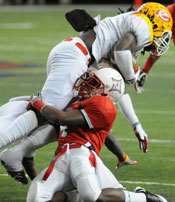Search the ArchivesUser loginGoogle AdsNavigationThings to do calendar
Browse archives
Business ShowcaseContact InformationThe Citizen Newspapers For Advertising Information Email us your news! For technical difficulties |
National bird returns as clear symbol of environmental progressToday, the bald eagle is a symbol of America, representing the pride, courage and strength of its people. For a long time, however, the symbolism and its symbol were separated and the eagle remained down, unappreciated and endangered. The recovery of the bald eagle is an appropriate banner not only for environmental restoration but for the surge of the nation in the last half of the century. They go hand-in-hand. This country’s economic vitality, confidence and pride have boomed. So has the eagle. As President Clinton said in 1994, “The fact is that only a prosperous society can have the confidence and the means to protect its environment.” This prosperous nation is protecting its environment, including its eagles. The bald eagle officially became the national emblem in 1787. Yet for much of the 19th and 20th centuries, the bird was persecuted. More than 100,000 eagles were killed in the Alaskan Territory between 1917 and 1950 for bounties ranging from 50 cents to $2 each. That is about five times the eagle numbers in the lower 48 states in 2006. In fact, a Georgia Fish and Game publication of the late 1920s reported: “Practically all of the birds in the state are protected by game laws. However, there are a few birds that are not protected. The hawk, eagle, owl, crow, sparrow, and meadow-lark are considered to do more harm than good and may be shot at any time.” Note that it was the state of Georgia then advocating the shooting of eagles. In 2000, the Georgia Department of Natural Resources was among those repeating the most common explanation of eagle decline: that “bald eagles suffered significant declines in the 1950s and 1960s primarily as a result of dichloro diphenyl trichloroethane (DDT) poisoning.” The truth is eagles were in danger long before then, most likely as the result of indiscriminate shooting. In the Audubon Society’s Christmas Bird Counts fewer eagles were seen early in the 20th century, before the introduction of DDT, than during the period when DDT was used (about 1945-75). In a biological reconnaissance of the Okefenokee Swamp from May to July 1912, neither bald eagles nor their nests were seen. The book “Georgia Birds” (1958) contains this about the bald eagle: “It has been seen from time to time in the interior of the state where it is not known to nest.” Between the late 1960s and 1980 there were no eagle nests in Georgia, but the number has increased every year since then, reaching 94 in the 2005-2006 nesting season, with 120 young eagles. The recovery of this national symbol is a clear indication of our environmental progress, emphasizing the tie President Clinton referred to between environmental protection and our prosperous society. Benjamin Franklin once wrote, “I wish that the bald eagle had not been chosen as the representative of our country, he is a bird of bad moral character, he does not get his living honestly, you may have seen him perched on some dead tree, where, too lazy to fish for himself, he watches the labor of the fishing-hawk, and when that diligent bird has at length taken a fish, and is bearing it to its nest for the support of his mate and young ones, the bald eagle pursues him and takes it from him.” It was Americans’ good fortune that Franklin lost his campaign for the wild turkey as our national symbol; imagine the jokes. Today, this nation soars like our national bird. Our progress, prosperity and desirability are highlighted by those abroad who patronize American companies, listen to the latest American tunes or apply to immigrate here. Forget about imitation; immigration is the sincerest form of flattery. Still, one wonders what Franklin, legendary for his wisdom, inventiveness and statesmanship, might say about the small minority perched on pessimism and ready to snatch from us the environmental successes that have grown out of our prosperity. I’m guessing it would be about as complimentary as his opinion of the bald eagle. login to post comments | Dr. Harold Brown's blog
|
AdvertisementsWho's new
Recent Comments
Who's onlineThere are currently 0 users and 51 guests online.
Recent blog posts
New forum topicsActive forum topics
Recent staff blog posts
|
From Our Galleries Random Photos are from:
Featured Columnists
More Columnists |
|||||||||||||||||||||||||||||||||||||||||||||||||||||||||||||||||||||||||||||||||||||||||||||||||||||||||||||||